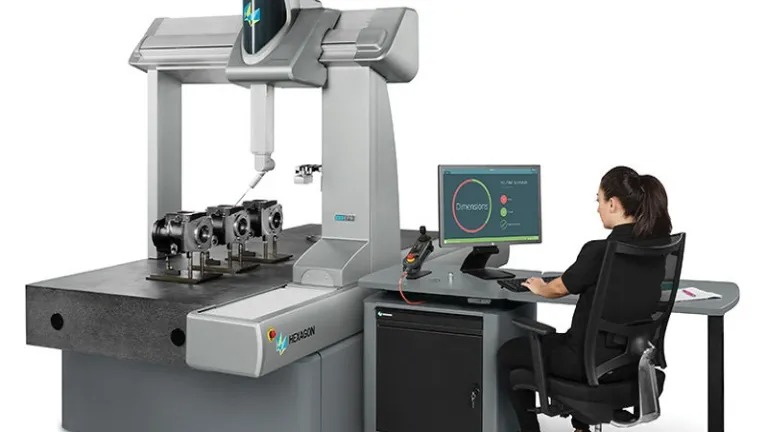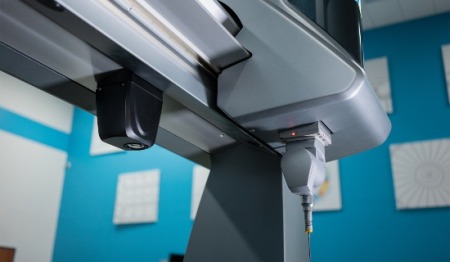A CMM can easily remain in service 20 years, which given the pace of technological change could have its challenges. Even the oldest CMMs, however, have proven adept at adapting to new technologies such as optical sensors, user friendly metrology software and asset management systems.
 Now, however, digital transformation is making fresh demands on CMMs to be interconnected and communicative. Without the ability to collaborate with other systems and people on the shop floor, CMMs risk becoming an information black hole that prevents the real-time data flow required for smarter manufacturing.
Now, however, digital transformation is making fresh demands on CMMs to be interconnected and communicative. Without the ability to collaborate with other systems and people on the shop floor, CMMs risk becoming an information black hole that prevents the real-time data flow required for smarter manufacturing.
But for many CMMs, the collaboration with modern IT systems that enables data transformation takes them outside their traditional comfort zone. Whereas the adoption of digital optical measurement, for example, is taking place within the confines of the metrology department, the quality team now increasingly needs to share metrology data in real time across the entire manufacturing workflow, from design and engineering, through to production.
Older CMMs, however, were designed to function within quality department silos, with CMM operators gathering information that often only they know how to read, act on and share.
Enterprise-Wide Collaboration
One of the longer-term goals of digital transformation is to achieve real-time collaboration and information exchange between systems and people across an organisation so that operations become more flexible, faster and smarter. Armed with highly relevant, real-time data, people will find it easier to innovate and take and implement decisions that improve customer experience and employee satisfaction, as well as business performance.
So, why does quality control have an important role to play in delivering a more connected, analytical and collaborative way of working? The traditional argument for investing in quality control is that it’s the cost of doing business. Inspection performs the essential role of ensuring customers receive the quality they have paid for and guarantees a manufacturer’s compliance with regulations. In addition, spotting errors quickly through regular quality control reduces waste and the need for rework, thereby lowering costs and raising throughput. But all these activities can be – and even today often are — performed within a silo.
Any manufacturer, however, that wants to benefit from digital transformation needs to be able to rapidly feed real-time quality data into design, engineering and production systems. Only in this way can they enable fast, intelligent improvements to product development and manufacturing based on an understanding of physical reality as well as virtual designs.
Digitally transforming inspection technology will also enable manufacturers to adapt to a changing workforce. New recruits to manufacturing have grown up with open, collaborative IT systems that enable agile working. Forcing them to work within closed proprietary industrial technology systems limits their capacity to take on new responsibilities and adapt swiftly to changing business requirements.
Putting CMMs at Heart of Data Driven Smart Manufacturing
The challenge now facing manufacturers is how to enable metrology systems to collaborate and provide the rest of the business the quality information they need in real-time, without compromising security, accuracy, precision or performance.

That’s why Hexagon Manufacturing Intelligence have taken a multi-pronged approach to putting CMMs at the heart of data-driven, smarter manufacturing. In addition to traditional strengths in security, performance, accuracy and precision, the latest collaborative systems technology for CMMs focuses on bolstering ease of use and real-time data exchange.
Ease of use is an enormous factor in the success of digital transformation projects. If it’s not easy for people to adjust to new ways of working, then they will ignore or resist change. It is also important to remember that the latest generation of CMM operators have grown up with consumer technology and expect collaboration between people and machines to be intuitively simple and real-time, with information provided in formats that are easy to understand and share.
For this reason, Hexagon Manufacturing Intelligence have designed collaborative systems for CMMs to provide operators more control over how they access, manage, share and analyse information.
One example is Digital Control Center (dCC). It’s a handheld device that gives users instant access to metrology software in a tablet-format from anywhere near the CMM, doing away with the need to switch between computer and jogbox. And it does so in a way that feels familiar because dCC we ensures the thumb stick controls functioned similarly to those on game pads.
Other recently introduced products from hexagon to aid data-driven transformation include the EYE-D technology which automatically recognises a workpiece, aligns it, and executes the right inspection routine, freeing up operators to perform other value-added tasks. And the data it captures integrates with wider software systems to enrich the analysis of the entire manufacturing and quality control process. The PULSE software meanwhile, enables users to receive remote notifications of any significant changes in vibrations, humidity, air pressure, and crash notifications, freeing them to move around the shop floor and Hexagon’s automated CMM part loading and unloading system, TEMPO, enables organisations to run entire inspection shifts unmanned, driven by data.
For more information: www.hexagonmi.com
Tags: 3d vina, Enabling CMMs for Production-Wide Data-Driven Transformation, hiệu chuẩn, hiệu chuẩn thiết bị, máy đo 2d, máy đo 3d, máy đo cmm, sửa máy đo 2d, sửa máy đo 3d, sửa máy đo cmm
